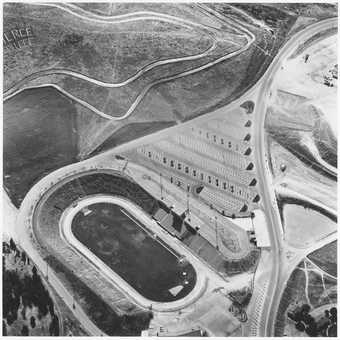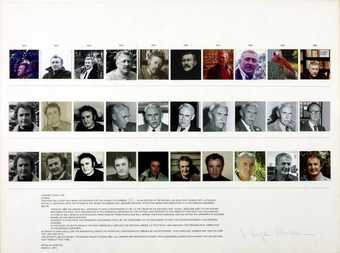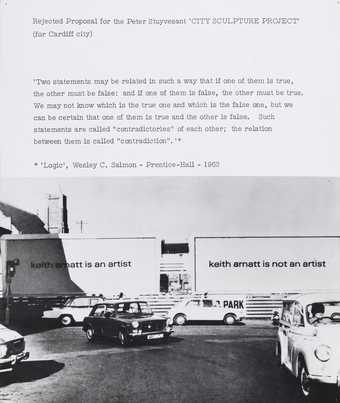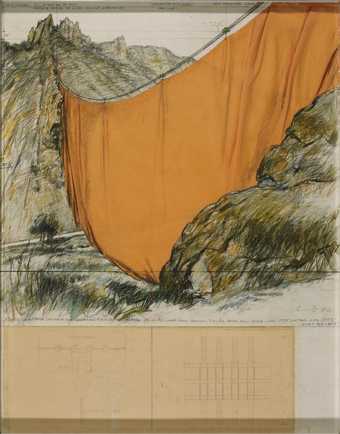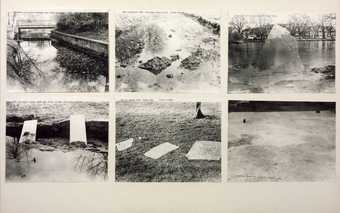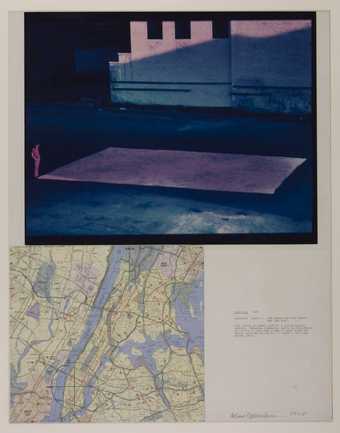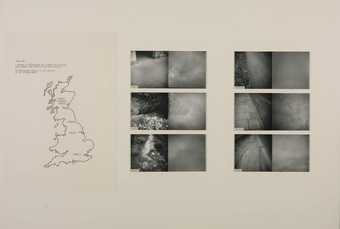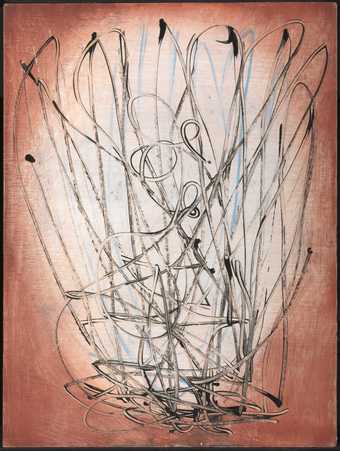
Not on display
- Artist
- Douglas Huebler 1924–1997
- Medium
- 2 maps, 5 photographs and typescript on board
- Dimensions
- Frame: 625 × 1282 × 31 mm
- Collection
- Tate
- Acquisition
- Presented by Mr and Mrs Joshua A. Gollin through the American Federation of Arts 1973
- Reference
- T01823
Display caption
Huebler's site sculptures explore ideas of location, documented through photography, maps and text. He only spent a day at Windham College in Vermont. Using a map, he drew a pentagon with the campus as its centre and then proceeded to collect earth from the locations that correspond to its five points. Mixed with resin, the samples were shown at Windham College with documentary materials. After the exhibition, they were reburied on campus.
Gallery label, August 2004
Does this text contain inaccurate information or language that you feel we should improve or change? We would like to hear from you.
Catalogue entry
Douglas Huebler born 1924 [- 1997]
T01823 Site Sculpture Project, Windham College Pentagon, Putney, Vermont
1968
Inscribed 'Douglas Huebler | 1968' on map of Putney countryside, centre r. and again on US Geological Survey map b.r.
Two maps, five photographs and typescript with text mounted on card, 24 1/2 x 50 1/4 (61.5 x 127.5)
Presented by Mr and Mrs Joshua A. Gollin through the American Federation of Arts 1973
Prov:
With Leo Castelli, New York (purchased from the artist 1973); Mr and Mrs Joshua A. Gollin, New York
Exh:
Group Exhibition, Leo Castelli, New York, Summer 1973 (no catalogue)
Lit:
Lucy Lippard (ed.), Six Years: The Dematerialisation of the Art Object from 1966 to 1972
(London 1973), p.57
The typewritten statement which forms part of this work reads as follows:
Site Sculpture Project
Windham College Pentagon
Putney, Vermont
On October 23, 1968 a small quantity of dirt was removed from each of five sites (each being located approximately 1.33 miles from a central point on the Windham College campus) and then mixed with an expoxy composition that was cured to finally form a wedge shape. In turn the five wedges so formed were placed together in such a manner as to describe a small pentagonal shape that was exactly similar to the 'shape' created by sites A B C D E.
The 'object', two maps locating A B C D E and five Polaroid photographs of the sites formed a presentation of this piece that was located at the central point (Windham College).
Approximately one month later the 'wedges' were returned to the earth and the maps, photographs and this statement constitute the completed work.
November, 1968 Douglas Huebler
Huebler told the compiler that he was director of an art department at Bradford Junior College, Bradford, Mass, in 1968 and was able to sponsor an exhibition of Robert Barry, Lawrence Weiner and Carl Andre at Bradford from 4 February-2 March 1968 which also included a symposium. Barry and Weiner showed paintings; Andre showed a floor piece of zinc plates. As Huebler was acting as host he didn't himself participate. The organisation was done by Seth Siegelaub.
The idea then arose of holding a similar exhibition of the same three artists at Windham College in Putney, Vermont. Seth Siegelaub contacted the sculptor Chuck Ginnever, who held a position there corresponding to Huebler's and who had seen the Bradford show, and Ginnever agreed to put on another exhibition and symposium. This exhibition took place from 30 April-31 May 1968 and was held out of doors. Andre made his first outdoor work out of bales of hay, Barry stretched nylon cord between two buildings and Weiner made a grid of staples, stakes, twine and turf. At Siegelaub's suggestion it was also arranged that Huebler should have an exhibition there, but separately.
Huebler had begun working outside at the same time and had become very interested in maps as a conceptual way of describing space. (One believes and perceives oneself to be in a certain place. A place can be described verbally or with a map. Borders are ideas on a map. You accept a place on a map as a matter of faith). He had produced his earliest map pieces in 1967 in a very tentative way, while still engaged on making his last Minimal sculptures, by mapping out car journeys. Then in the summer of 1968 in New York he made a number of map pieces, for instance by marking the 42nd parallel by mailing a package along that line coast to coast, and making an 'exchange' piece by imposing the same shape on maps of New York and Boston. Some of these involved plotting out points on a map in the form of a hexagon or a circle, and then visiting the actual sites and putting down paper markers to mark out the space. He had also begun to take photographs of these places as a record. The documentation on several of these works was reproduced in a catalogue Douglas Huebler: November, 1968
published by Seth Siegelaub in November 1968, the first exhibition to exist solely as a catalogue.
For his exhibition at Windham College, he knew that he was expected to create a work at Windham and give a lecture. In order to get as much as possible ready in advance, he asked Ginnever to send him a map of the area and drew a pentagon on it, using the campus as the centre. He also wrote the statement beforehand and made five wedge-shaped triangular containers for the earth and a stand in the shape of a pentagon measuring about 75cm across.
Then on 23 October 1968 he went to the five sites. Having been to Putney before to see the previous exhibition, he knew that the area was very rural and wooded, so he had tried to pick locations as close to roads as possible, but in some cases he had to penetrate quite far into the forest. Each of the five containers was filled with earth mixed with epoxy resin which he had brought with him in the car. He also took Polaroid photographs of each location, pointing the camera more or less at random.
When this had been completed, he went to Windham College, set up the exhibition (consisting only of this one work) and gave the lecture, all on the same day. The triangular-shaped wedges of earth were exhibited on the stand, fitted together like slices of a cake, and the maps, text and photographs were displayed on the wall. That night he gave a lecture explaining to the students what he had done. The piece remained on view at Putney for about a month, when he asked Ginnever to post the information back to him and bury the earth somewhere on the campus. He never subsequently went back there. The piece represents one day in Putney.
Although this work is pastoral and lyrical (and therefore suitable for the occasion), Huebler says that producing a piece in the countryside was no different for him than making one, say, in New York City. His interest then was in space. At this period he was involved with Weiner, Barry and Kosuth in an explosion of ideas and in exploring many different kinds of systems, including time, tides, human systems and mailing systems. He and his friends supported and encouraged one another, and made discoveries which surprised even themselves.
The reason why he used a Polaroid camera to photograph the sites was because the photographs had to be developed straight away. In any case he had no skill as a photographer at that time and only owned a Polaroid. He did not realise until later that the Polaroid prints would be impermanent and he only rephotographed them about two years later. Apart from the photographs, all the documents in the Tate's work are the original ones.
As is his usual practice, he also made a copy of this work to keep and for exhibition purposes, and as a precaution in case the original was lost or damaged. He asked Ginnever to send him another copy of the map but Ginnever was unable to find one, so he had to make do with a xerox facsimile. The copy also differs from the original in having a different arrangement of the items, in being unsigned and in having a label stamped COPY. It has been exhibited in Huebler's one-man retrospectives at the Westfälischer Kunstverein, Münster, 1972-3, Boston Museum of Fine Arts, 1973, the Israel Museum, Jerusalem, 1973, the Idea and Image in Recent Art
exhibition at the Art Institute of Chicago, 1974, and the Interventions in the Landscape
exhibition at the Hayden Gallery, the Massachusetts Institute of Technology, 1974.
Published in:
Ronald Alley, Catalogue of the Tate Gallery's Collection of Modern Art other than Works by British Artists, Tate Gallery and Sotheby Parke-Bernet, London 1981, pp.365-7, reproduced p.365
Explore
- emotions, concepts and ideas(16,416)
-
- formal qualities(12,454)
-
- classification(114)
- diagrammatic(799)
- photographic(4,673)
- space(177)
- universal concepts(6,387)
-
- environment / nature(315)
- scientific and measuring(791)
-
- map(110)
- USA, Vermont(3)
- education, science and learning(1,416)
-
- geography(7)
You might like
-
Edward Ruscha Pierce College, Woodland Hills
1967, printed 1999 -
Douglas Huebler Variable Piece No. 44
1971 -
Christo (Christo Javacheff) Valley Curtain (Project for Colorado) Rifle, Grand Hogback
1971 -
Bruce McLean Six Sculptures
1967–8 -
Keith Arnatt Self-Burial (Television Interference Project)
1969 -
Dennis Oppenheim Salt Flat
1968 -
Richard Long CBE Untitled
1967 -
Dennis Oppenheim Directed Harvest
1966 -
Dame Barbara Hepworth Spring, 1957 (Project for Sculpture)
1957

